Pickled Bell Peppers Canning Recipe
This post may contain affiliate links, which means that I may receive a commission if you make a purchase using these links. As an Amazon Associate I earn from qualifying purchases.
Looking to preserve the vibrant taste of fresh bell peppers? Our pickled peppers canning recipe is the perfect solution! These tangy and sweet pickled peppers are a delicious addition to your pantry, offering a burst of flavor that can brighten up any meal.
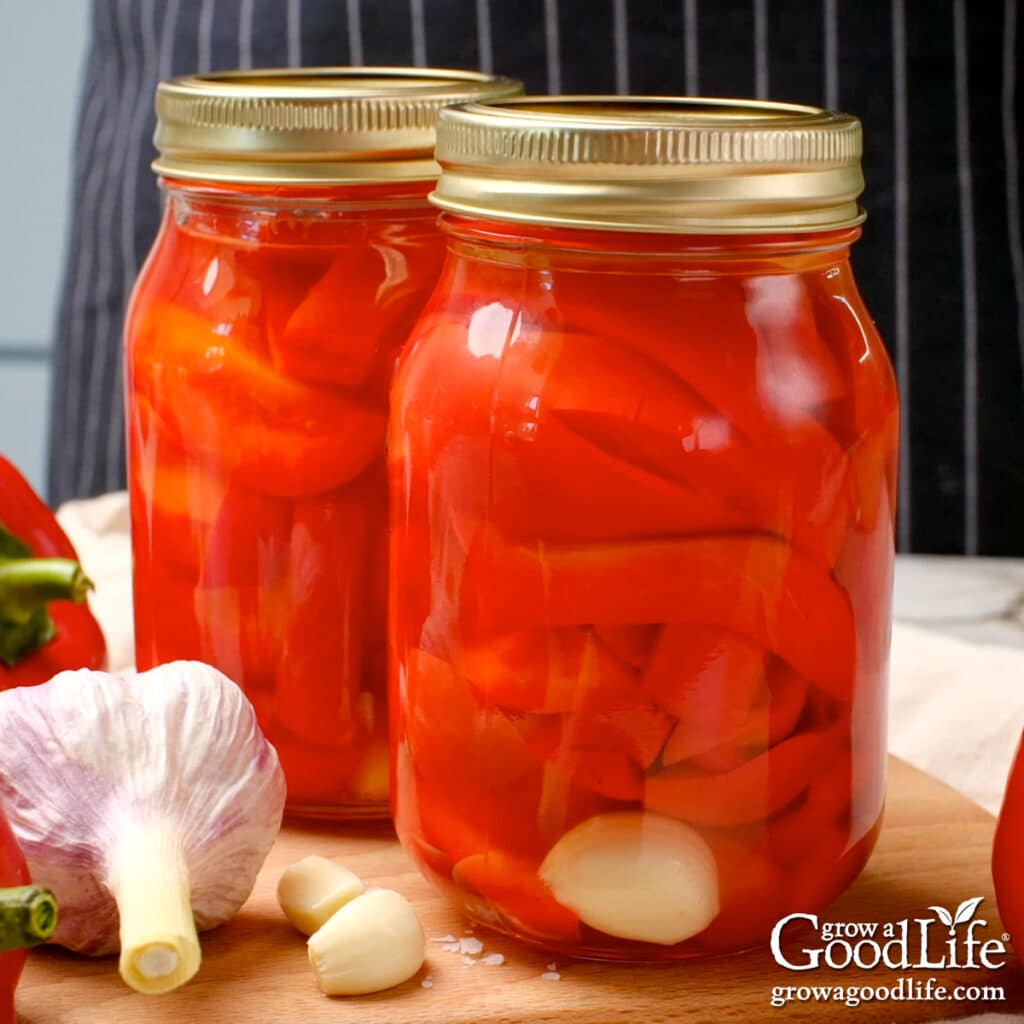
Growing peppers in gardening areas with short summers can be a challenge. To compensate, I tend to plant a lot of pepper plants so I can gather enough fruit before our first fall frost. If the summer weather is exceptionally warm, I often end up with a bumper crop.
This abundance can be overwhelming, especially if all the peppers ripen at once or if a sudden freeze warning forces me to harvest all the fruit to avoid losing the entire crop. Fortunately, there are many ways to preserve peppers, such as dehydrating, freezing, and various home canning methods like making salsas, pressure canning roasted peppers, or turning them into marinated pickled peppers.
When dealing with a large amount of ripe bell peppers that need to be preserved quickly, this pickled peppers recipe is my go-to method. It’s an easy yet delicious canning recipe that ensures none of your garden’s bounty goes to waste.
In this recipe, fresh peppers are cut into strips and infused with a simple but delicious pickling brine. They are then processed in a water bath canner for shelf-stable jars. I am always happy to have jars of pickled peppers on hand to add flavor to our meals.
About the Ingredients
Pickling peppers is an excellent way to preserve your harvest. You can enjoy them chopped in a salad, tossed on burgers and sandwiches, stuffed in tacos, on a charcuterie board, or simply as a snack right out of the jar.
The success of any canning recipe starts with choosing the right ingredients. For these pickled sweet peppers recipe, you’ll need:
Ripe Sweet Bell Peppers
Red bell peppers are the star of this pickled sweet peppers recipe, but you can use any sweet pepper. A mix of red, yellow, and orange bell peppers will add vibrant color to your jars. You can also use green bell peppers, but they taste slightly more bitter than their fully ripened counterparts.
Select firm, glossy peppers free from blemishes or soft spots. Fresh, high-quality peppers will yield the best results. You will need about 7 pounds of peppers.
Did you know that peppers will continue to ripen off the vine? Most bell pepper varieties start off green and gradually turn their final color when fully ripe. If you have green peppers at the end of the season, they can be ripened indoors for a sweeter flavor before preserving. Here’s how you can ripen bell peppers indoors:
- Pick your peppers when they are mature but still green. Look for peppers that are fully grown and have a firm texture.
- Place them in a warm, dry area indoors. A spot with plenty of natural light, such as a windowsill or a countertop, works well. The temperature should ideally be between 55-70°F (13-21°C).
- Provide good air circulation and avoid overcrowding to prevent mold and spoilage.
- Check the peppers daily for signs of ripening. As they ripen, they will change from green to yellow, eventually to red or their final color. Depending on the fruit’s maturity and indoor conditions, the process can take anywhere from a few days to a few weeks.
Allowing your green peppers to ripen indoors enhances their sweetness and flavor, making them perfect for pickling. This step is especially useful if you have an abundance of green peppers at the end of the growing season.
Commercial Vinegar with 5% Acidity
Using vinegar that is at least 5% acidity is important for canning safely to prevent the growth of botulinum bacteria. The most common types of vinegar used for canning are distilled white vinegar and apple cider vinegar:
- White vinegar is clear vinegar made by distilling corn and rye. The flavor is sharper than apple cider vinegar.
- Apple cider vinegar is made from fermented apples and adds a mild sweet apple flavor to pickled foods. However, it will slightly darken the color of your peppers, especially if you are using yellow peppers.
Additional Flavorings
- Sugar: White, granulated sugar adds a touch of sweetness to balance the tanginess of the vinegar. Feel free to adjust the amount to suit your taste.
- Garlic: Optional but including one clove per jar infuses the peppers with a subtle, savory flavor.
- Pickling Salt: Also called canning salt, it enhances the overall taste.
Safe Ingredient Changes or Substitutions
While canning recipes are tested as written, you can safely make some changes and substitutions to this research-tested recipe. However, keeping the proportions of peppers, vinegar, and water the same is crucial to ensure safe pickling. A pickled product’s acidity level is as important for its safety as it is for its taste and texture.
- Swap out bell peppers for another type: You can use any variety of peppers, including Cubanelle, Hungarian, yellow wax, sweet cherry, and sweet banana peppers. Swap out the same amount that is called for in the recipe. Peppers with thick flesh hold up the best to the canning process.
- Substitute the vinegar: While this recipe calls for distilled white vinegar, you can substitute commercial apple cider vinegar with 5% acetic acid.
- Reduce the amount of sugar: You can reduce the amount of sugar used in the recipe. Unfortunately, there are no tested recipes using Sucrose, Stevia, or other sugar substitutes. They may alter the pH or cause flavor changes.
- Adjust the salt: Pickling salt is pure granulated salt (sodium chloride) without the anti-caking agents or additives commonly found in table salt. While pickles may be home canned safely with reduced or no salt, it will affect their texture and flavor. You can substitute Kosher salt or sea salt that is pure and free from additives. Keep in mind that salt grains can vary in size, so adjust accordingly to match the salinity of pickling salt.
- Add calcium chloride: Food-grade calcium chloride, such as Ball Pickle Crisp and Mrs. Wages Xtra Crunch, can be used for added crispness. Calcium chloride is a firming agent that can be used in quick-processed pickles to help maintain a crisper texture. It works by firming the vegetable’s natural pectin. Follow the instructions on the container.
- Add dried spices: You can safely add up to 1/2 teaspoon of dried spices, such as dried herbs, red pepper flakes, mustard seeds, or mixed pickling spice to the jar for extra flavor.
- Use half-pint jars: You can preserve pickled peppers in half-pint jars instead of the pint jars called for in the recipe. It is safe to go down a jar size, but not up. The processing time stays the same.
Other than what is listed here, additional changes may make your pickles unsafe for canning and shelf storage. If you want to make further changes, skip processing your jars in a water bath canner and store them in the refrigerator for up to two weeks.
Steps for Canning Pickled Bell Peppers
Now that you know what ingredients you need, let’s move on to the recipe process to transform these vibrant peppers into shelf-stable jars of delicious pickled sweet peppers!
This recipe is the “Pickled Bell Peppers” recipe from the So Easy to Preserve and USDA Complete Guide to Home Preserving books, as well as the NCHFP website. Before you begin, reviewing the information on Using Boiling Water Canners on the National Center for Home Food Preservation website may be helpful.
You can find the full, printable recipe at the bottom of the article, but here are the detailed steps to making and canning pickled sweet peppers:
Step 1: Gather and Prepare Your Kitchen and Canning Equipment
You will need:
- Water bath canner with a canning rack
- 9 pint sized canning jars
- Canning lids and ring bands (new lids for each jar, bands can be reused)
- Canning tools: jar lifter, canning ladle, funnel, and bubble popper
- Plus basic kitchen supplies such as a knife, cutting board, large pot, large prep bowl, measuring cups, spoons, slotted spoon, and clean kitchen towels.
Wash the jars, lids, screw bands, and canning tools in hot soapy water. Rinse thoroughly to remove all suds. Check over the jars carefully and don’t use any with nicks or scratches.
Place the jar rack into the water bath canner, place jars in the canner, and add water to cover. Bring the canner to a simmer (180˚F) for 10 minutes, and keep the jars hot until you are ready to fill them.
Step 2: Prepare the Ingredients
Wash the peppers well under clean running water. Remove the stems, seeds, and membranes, then cut the peppers into strips. Place the pepper strips into a large prep bowl and set aside.
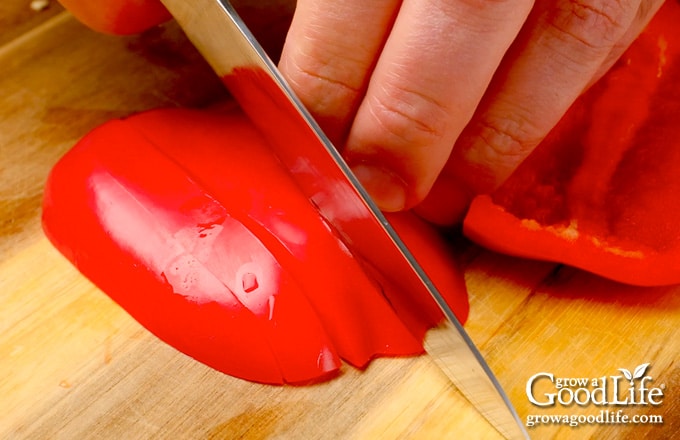
Combine the sugar, vinegar, and water in a large saucepan. Bring the vinegar mixture to a boil over medium-high heat, and boil for 1 minute.
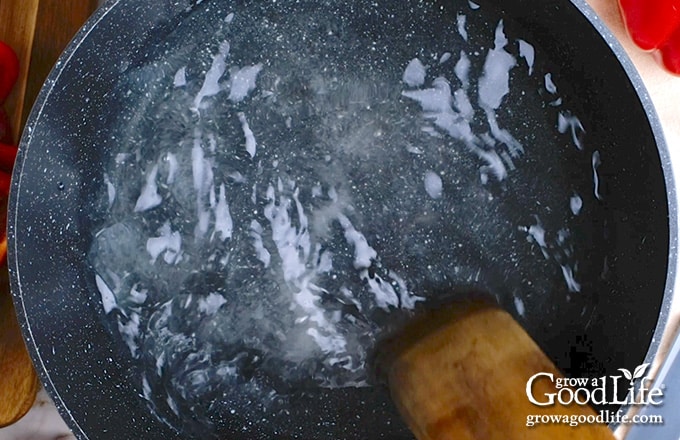
Add the prepared peppers to the pot, return to a boil, and keep hot as you fill your jars.
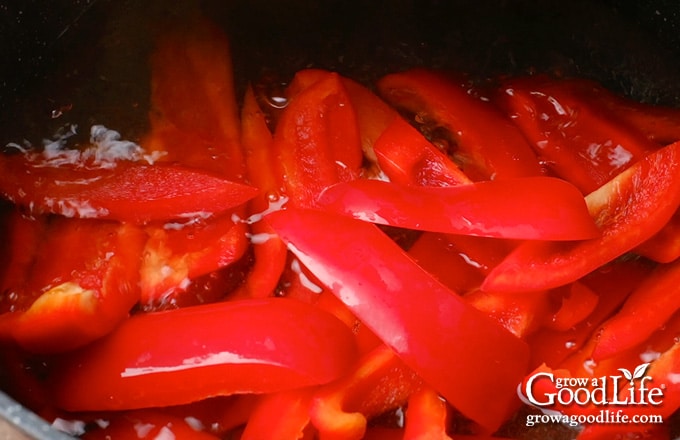
Step 3: Fill the Jars
Spread a kitchen towel on the counter. Using the jar lifter to remove one warm jar from the canner, drain the water back into the canner, and place the jar on the towel. Keep the remaining jars in the canner so they stay hot.
Add 1 clove of garlic and 1/2 teaspoon of salt to the jar.
Use a slotted spoon to fill the jar with hot peppers, then pour hot pickling liquid over the peppers, maintaining a 1/2-inch headspace.

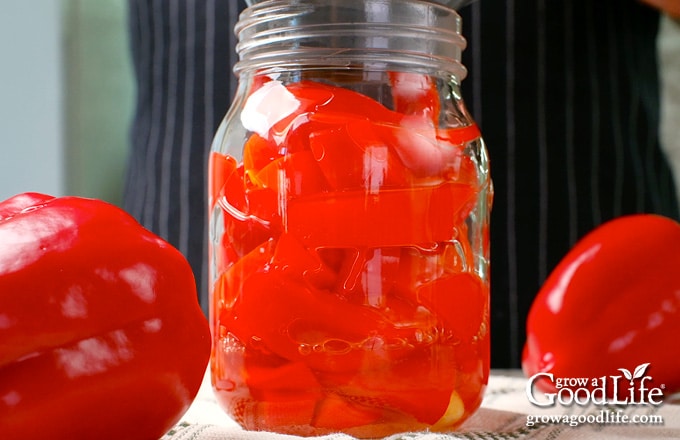
Run a bubble popper through the jar to release air bubbles. Then, adjust the headspace if needed. Wipe the rim clean with a damp paper towel.
Center a lid on the jar and screw on the band until it is fingertip tight. Use the jar lifter to place the jar back into the canner and repeat with the remaining jars.
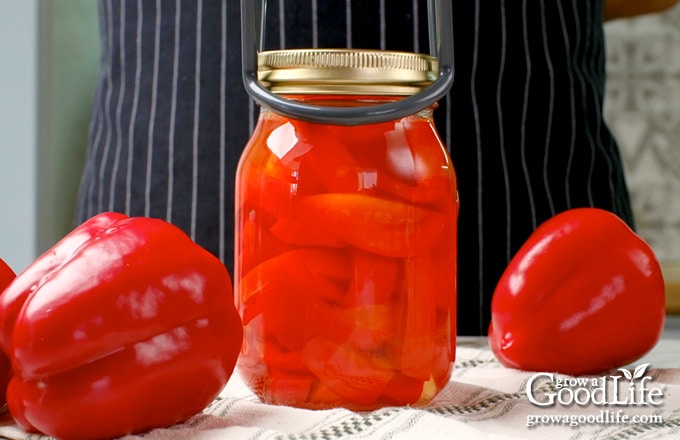
Step 4: Process in a Water Bath Canner
Once all jars are in the canner, adjust the water level to ensure it is two inches above the jar tops.
Cover the canning pot and bring it to a rolling boil over medium-high heat. Once boiling, start a timer and process for 10 minutes at altitudes less than 1,000 ft. Adjust processing time for your altitude if necessary.
When processing time is complete, turn off the heat, remove the cover by tilting the lid away from you to avoid steam burns, and allow the canner to cool and settle for 5 minutes.
Spread a dry kitchen towel on the counter. Using a jar lifter, remove the jars one at a time, keeping them upright and placing them on the towel, spacing them a few inches apart. Do not tighten the ring bands or test the seals yet. Let the jars sit undisturbed for 12 to 24 hours to cool, allowing the lids to seal properly.
Step 5: Check the Seals and Store the Jars
After at least 12 hours, check that the lids have sealed by pressing on the center of the lid. The lid should not pop up. If the lid flexes up and down, it did not seal. Refrigerate the jar and use it within a month.
Prepare your jars for storage by removing the ring bands and washing them well in warm, soapy water to remove any residue. Then, dry, label, and date the jars. Store in a cool, dark place between 50 and 70˚F. For the best flavor, use up your jars of pickled peppers within 12 to 18 months. Allow 4 to 5 weeks for the pickles to develop flavor before opening a jar. Once opened, refrigerate and use within a month. The recipe makes about 9 pints.
Enjoy Your Pickled Sweet Peppers! Whether snacking straight from the jar or adding a zesty kick to salads, sandwiches, and more, you’ll love having pickled sweet peppers on your shelves.
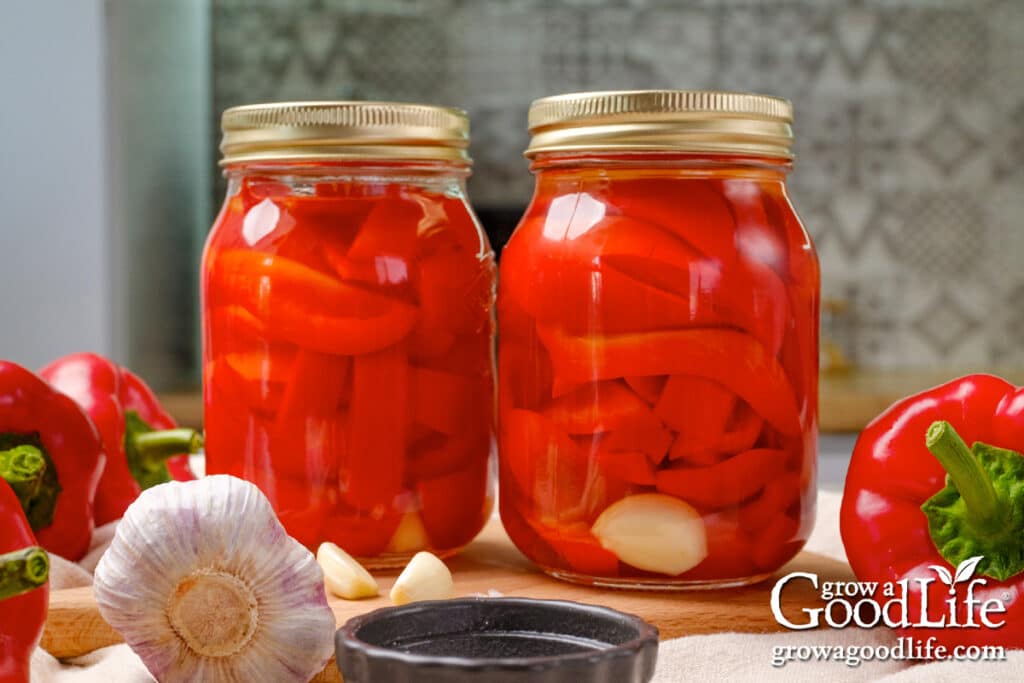
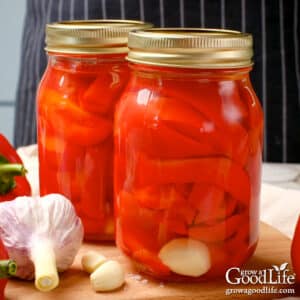
Pickled Sweet Peppers Canning Recipe
Ingredients
- 7 pounds ripe bell peppers or any pepper variety
- 3 cups sugar can reduce the amount if desired
- 3 cups white vinegar 5% acidity
- 3 cups water
- 9 cloves garlic 1 clove per jar – optional for flavor
- 4 1/2 teaspoons pickling salt 1/2 teaspoon per jar – optional for flavor
Instructions
Prepare the Canning Equipment
- Wash the jars, lids, screw bands, and canning tools in hot soapy water. Rinse well to remove all suds.
- Place the jar rack into the water bath canner, place jars in the canner, and add water to cover. Bring the canner to a simmer (180˚F) for 10 minutes, and keep the jars warm until you are ready to fill them.
Make the Pickled Peppers
- Wash the peppers well under clean running water, remove the stems, seeds, and membranes. Cut them into strips and set the sliced peppers aside.
- Combine the sugar, vinegar, and water in a large saucepan, bring it to a boil over medium-high heat, and boil for 1 minute.
- Add the prepared peppers to the hot brine, let the pot return to a boil, and boil for 1 minute. Keep hot as you fill your jars.
Fill the Jars
- Spread a kitchen towel on the counter. Using the jar lifter, remove a warm jar from the canner. Drain the water back into the canner and place it on the towel. Keep the remaining jars in the canner so they stay hot.
- Add 1 clove of garlic and 1/2 teaspoon of salt to the jar.
- Use a slotted spoon to fill the jar with hot peppers, and then ladle hot pickling liquid over the peppers, maintaining a 1/2-inch headspace.
- Run the bubble popper through the jar to release air bubbles. Wipe the rim clean with a damp paper towel.
- Center a lid on the jar, and screw on the band until it is fingertip tight. Use the jar lifter to place the jar back into the canner, and repeat with the remaining jars.
Process in a Water Bath Canner
- Once the jars are all in the canner, adjust the water level to two inches above the jar tops.
- Cover the canning pot and bring it to a rolling boil over medium-high heat. Once the pot boils, set a timer and process pints in a boiling water bath canner for 10 minutes at altitudes of less than 1,000 ft. Adjust processing time for your altitude if necessary. (See notes)
- When the processing time is complete, turn off the heat, remove the cover by tilting the lid away from you so that steam does not burn your face, and allow the canner to cool down and settle for 5 minutes.
- Spread a dry kitchen towel on the counter. Use a jar lifter to remove the jars one at a time from the canner. Keep the jars upright and place them on the towel. Do not tighten ring bands or test the seals yet. Let the jars sit undisturbed for 12 to 24 hours to cool.
- After the jars have cooled for at least 12 hours, check to be sure lids have sealed by pushing on the center of the lid. The lid should not pop up. If the lid flexes up and down, it did not seal. Place the jar in the refrigerator, and use within a month.
- Remove the ring bands, wash, label, date the jars, and store in a cool, dark place between 50 to 70 degrees F for 12 to 18 months. Allow 4 to 5 weeks for the pickles to develop flavor. Once the jar is open, refrigerate and use it within a month. Makes about 9 pints of sweet pickled peppers
Notes
Nutrition
You May Also Like:
- Pickled Jalapenos Canning Recipe
- Giardiniera Pickled Vegetables Canning Recipe
- How to Pressure Can Green Chile Peppers
40+ Meals in a Jar Pressure Canning Recipes
In this eBook, you will find 50 pressure canning recipes, including 44 meals, along with homemade stocks and bone broths. Recipes include soups, stews, chilis, beans, beef, pork, and poultry. Explore the world of preserving delicious home-cooked meals for all seasons.


I don’t use white sugar and 3 cups seems way too sweet. Would the recipe work if I use one cup of raw not white sugar? Also, are you saying I can safely put 1/2 tsp of mixed spice into each jar or the whole recipe? Thank you
Annie, Thanks so much for your questions! Yes, you can safely reduce the sugar to 1 cup if you prefer, and raw sugar can be used in place of white sugar. It may slightly change the flavor or color, but it will still work just fine. And yes, you can add up to 1/2 teaspoon of dried spices to each individual jar. These are all safe changes.
I know I made this recipe last year, but there is no way this is supposed to be 7 pounds of cut up peppers, right? That seems like an insane amount compared to the brine.
Kelly, The recipe calls for 7 pounds of ripe peppers, these are weighed before trimming and slicing. In recipes, the way the ingredient is written tells you when to weigh or measure it. For example: If the recipe says “7 pounds ripe bell peppers”, you weigh the whole peppers first (before seeding, trimming, and cutting), and then prepare them as directed. If it said “7 pounds sliced peppers”, you would slice the peppers first, then weigh out 7 pounds. I hope this helps.
Thank you, yes, it helps. I thought maybe I was going crazy!!